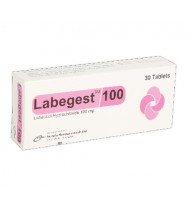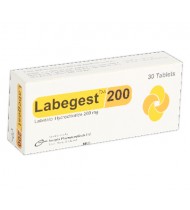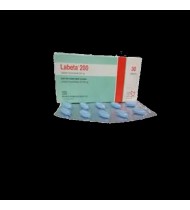Labetalol Hydrochloride (Tablet)
Indications
Labetalol Hydrochloride indicated in the management of hypertension. Labetalol tablets may be used alone or in combination with other antihypertensive agents, especially thiazide and loop diuretics.
Pharmacology
Labetalol non-selectively antagonizes beta-adrenergic receptors, and selectively antagonizes alpha-1-adrenergic receptors. Following oral administration, labetalol has 3 times the beta-blocking ability than alpha-blocking ability. This increases to 6.9 times following intravenous administration. Antagonism of alpha-1-adrenergic receptors leads to vasodilation and decreased vascular resistance. This leads to a decrease in blood pressure that is most pronounced while standing. Antagonism of beta-1-adrenergic receptors leads to a slight decrease in heart rate. Antagonism of beta-2-adrenergic receptors leads to some of the side effects of labetalol such as bronchospasms, however this may be slightly attenuated by alpha-1-adrenergic antagonism. Labetalol leads to sustained vasodilation over the long term without a significant decrease in cardiac output or stroke volume, and a minimal decrease in heart rate.
Dosage & Administration
Adult: The recommended initial dosage is 100 mg twice daily whether used alone or added to a diuretic regimen. The usual maintenance dosage of Labetalol Hydrochloride is between 200 and 400 mg twice daily.
Patients with severe hypertension: May require from 1,200 to 2,400 mg per day, with or without thiazide diuretics. Titration increments should not exceed 200 mg twice daily.
Elderly Patients: The majority of elderly patients will require between 100 and 200 mg twice daily.
Patients with severe hypertension: May require from 1,200 to 2,400 mg per day, with or without thiazide diuretics. Titration increments should not exceed 200 mg twice daily.
Elderly Patients: The majority of elderly patients will require between 100 and 200 mg twice daily.
Interaction
Labetalol in combination with tricyclic antidepressants may cause tremor; Cimetidine has been shown to increase the bioavailability of Labetalol. If Labetalol is used with nitroglycerin in patients with angina pectoris, additional antihypertensive effects may occur; Care should be taken if Labetalol is used concomitantly with calcium antagonists of the verapamil type; Both digitalis glycosides and beta-blockers slow atrioventricular conduction and decrease heart rate. Concomitant use can increase the risk of bradycardia.
Side Effects
Most side effects are mild and transient and occur early in the course of treatment. The incidences of adverse reactions include Fatigue, Asthenia, Headache, Nausea, Vomiting, Dyspepsia, Abdominal pain, Diarrhea, Taste distortion, Dizziness, Paresthesia, Nasal stuffiness, Increased sweating, Edema, Postural hypotension, Bradycardia, Dyspnea, Rash, Vision abnormality and Vertigo.
Pregnancy & Lactation
Pregnancy Category C. Teratogenic studies were performed with Labetalol in rats and rabbits at oral doses up to approximately six and four times the maximum recommended human dose (MRHD), respectively. No reproducible evidence of fetal malformations was observed. Labetalol Hydrochloride given to pregnant women with hypertension did not appear to affect the usual course of labor and delivery. Small amounts of Labetalol (approximately 0.004% of the maternal dose) are excreted in human milk. Caution should be exercised when Labetalol tablets are administered to a nursing woman.
Precautions & Warnings
Labetalol Hydrochloride should be used with caution in patients with Impaired Hepatic Function, Congestive Heart Failure, Exacerbation of Ischemic Heart Disease, Nonallergic Bronchospasm, Pheochromocytoma, Diabetes Mellitus and Hypoglycemia.
Overdose Effects
Overdosage with Labetalol causes excessive hypotension and sometimes, excessive bradycardia. If overdosage with Labetalol follows oral ingestion, gastric lavage or pharmacologically induced emesis (using syrup) may be useful for removal of the drug shortly after ingestion. The following additional measures should be employed if necessary: Excessive bradycardia-administer atropine or epinephrine; Cardiac failure-administer a digitalis glycoside and a diuretic; Hypotension-administer vasopressors, e.g., norepinephrine; Bronchospasm administer epinephrine and/or an aerosolized beta2-agonist; Seizures-administer diazepam. In severe beta blocker overdose resulting in hypotension and/or bradycardia, glucagon has been shown to be effective when administered in large doses (5 to 10 mg rapidly over 30 seconds, followed by continuous infusion of 5 mg per hour that can be reduced as the patient improves).
Therapeutic Class
Alpha adrenoceptor blocking drugs, Beta-adrenoceptor blocking drugs
Storage Conditions
Labetalol tablets should be stored below 30°C. Keep out of the reach of children. Store in a cool and dry place protected from light.
Labegest Tablet 100 mg
IndicationsLabetalol Hydrochloride indicated in the management of hypertension. Labetalol tablets ma..
6.00Tk.
Labegest Tablet 200 mg
IndicationsLabetalol Hydrochloride indicated in the management of hypertension. Labetalol tablets ma..
10.00Tk.
Labeta Tablet 100 mg
IndicationsLabetalol Hydrochloride indicated in the management of hypertension. Labetalol tablets ma..
5.50Tk.
Labeta Tablet 200 mg
IndicationsLabetalol Hydrochloride indicated in the management of hypertension. Labetalol tablets ma..
9.00Tk.
Showing 1 to 4 of 4 (1 Pages)



